Table of contents
- Out and about in Thailand Enduro tour through the jungle of Thailand
- Out and about in Thailand part 2
- Info about Thailand
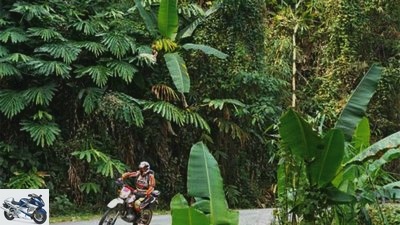
Iron ham
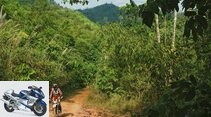
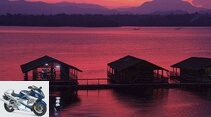
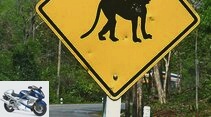
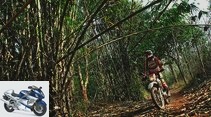
21 pictures
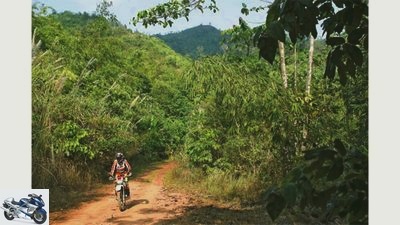
Iron ham
1/21
Even a small-volume enduro is enough to experience driving fun and typical exoticism on Thai jungle slopes and asphalt roads in maximum dose.
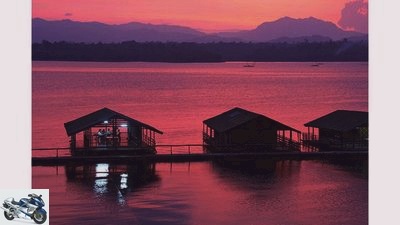
Iron ham
2/21
An idyllic lodge on the Khao Laem reservoir.
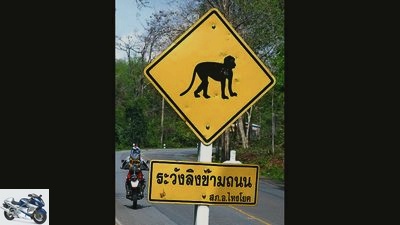
Iron ham
3/21
Beware of the streets. Monkeys also like to sunbathe on the asphalt.
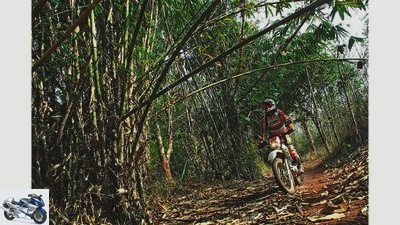
Iron ham
4/21
Off through the bamboo jungle near Kanchana Buri. But there wasn’t nearly as much space as here on many trails.
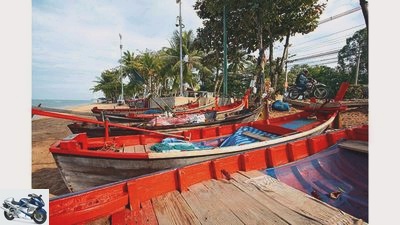
Iron ham
5/21
From the coast of Thailand, the tour continues north-west into the jungle. Until roads have to give way to small trails.
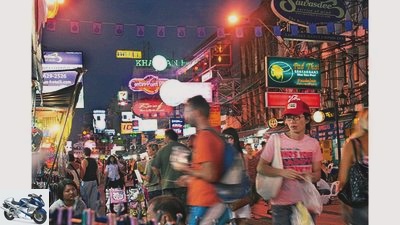
Iron ham
6/21
If you are already on the move, you should definitely pay a visit to the urban jungle of Bangkok, as here in the Traveler District.
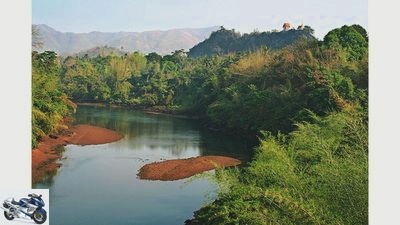
Iron ham
7/21
At the headwaters, the Kwai is calm and looks very tranquil.
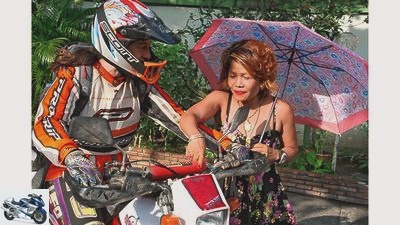
Iron ham
8/21
For the Thai woman, an enduro rider from Europe is very exotic.
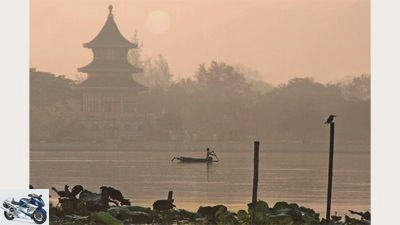
Iron ham
9/21
Quiet morning mood on the Kwai.

Iron ham
10/21
Slopes at the border are sometimes no longer cleared. The border to Burma is closed until further notice.
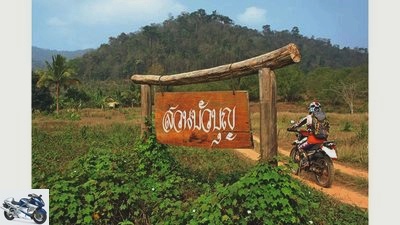
Iron ham
11/21
But it also drives on the slopes without any problems.
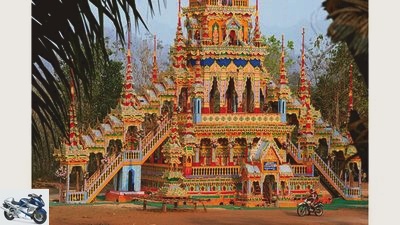
Iron ham
12/21
The Mon temple in Sankhla Buri looks like from another world.
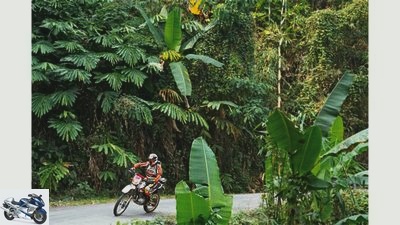
Iron ham
13/21
The agile Serow also feels at home on asphalt.
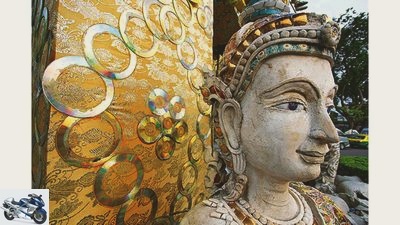
Iron ham
14/21
Here old CDs serve as jewelry for Buddha.
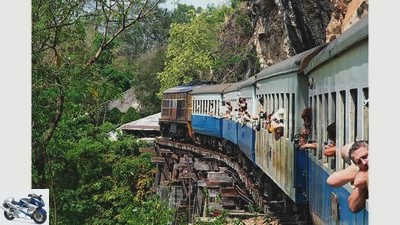
Iron ham
15/21
the “Death Railway” from the Kwai River to Nam Tok was built at great sacrifice by Australian, Dutch and British prisoners of war during World War II. The Japanese wanted to create a connection to Burma by rail.
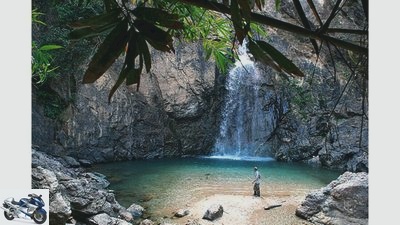
Iron ham
16/21
Picturesque little waterfalls in the middle of the jungle sweeten the breaks during the trip.
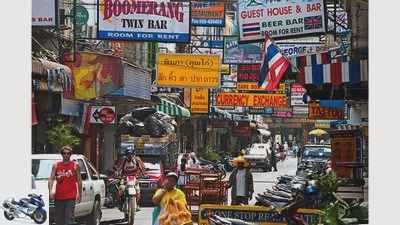
Iron ham
17/21
One thing is clear: Bangkok is much more colorful than Bochum.
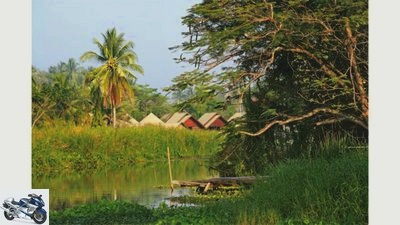
Iron ham
18/21
We still pass villages and rice fields, which, however, on the edge of the Sai Yok National Park, are only a transit station.
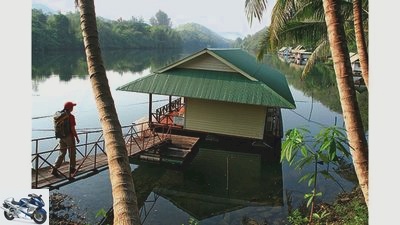
Iron ham
19/21
Not uncommon: houseboats on the quiet Kwai upper reaches.
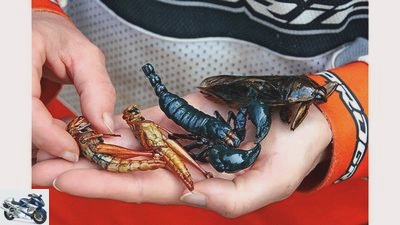
Iron ham
20/21
Not uncommon as a snack in Thailand: fried scorpions and grasshoppers.
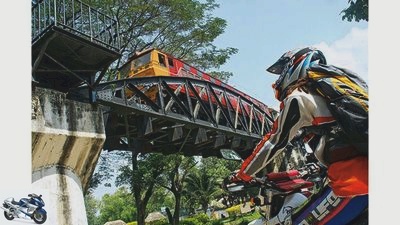
Iron ham
21/21
You also pass the bridge on the Kwai, whose wooden predecessor gave the film its name.
to travel
On the way through the jungle of Thailand
Out and about in Thailand
Enduro tour through the jungle of Thailand
Ten years ago, motorcycle scout Harry explored the terrain through the Thai jungle with his Enduro to build a pipeline. Today he takes Sylvia Lischer (text) and Gerhard Eisenschink (photos) with him on the trails that tigers also like.
Markus Biebricher
02/18/2010
Car traffic pulsates in a stop-and-go manner along six-lane streets. Mopeds compete with wildly painted motorcycle rickshaws as the unofficial seventh and eighth lane razor-sharp past sidewalks. Mobile food stalls chase over intersections, water taxis saw through canals with gigantic bow waves. A Yamaha XT 225 whizzes past dealers who skillfully juggle piled fruits on rickety handcarts through the traffic. A completely normal evening in Bangkok, a challenge for me, the tired enduro rider from Germany.
Buy complete article
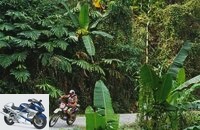
Out and about in Thailand
Enduro tour through the jungle of Thailand
9 pages) as PDF
€ 2.00
Buy now
Jungle scout Harry, behind whose enduro I fight my way through the urban canyons of the seven million city, takes it easy. He has known Thailand and the mega-city Bangkok for years. Residential towers over 60 stories high pass by in the corner of your eye, followed by mega malls with branded items on 19 floors. Then the Sky Train appears, an elevated railway built on concrete stilts. The train rushes from one end of the city to the other in just a few minutes. Nevertheless, helicopters are constantly flying high society from the roof of one skyscraper to the next.
Stopover at Wat Pho, one of around 400 Buddhist temples in Bangkok, where you can escape the hustle and bustle of the urban jungle for a while. Then we steer the enduros into the traveler district of Thanon Kao San and go through the planned route into the real Thai jungle again with fried water beetles with soy dip: Kanchanaburi, Sai Yok National Park, Sankhla Buri, three pagodas -Pass and on the way back the old royal city of Ayutthaya.
While we indulge in jungle fantasies, techno rhythms boom from the pubs and tattoo shops all around. Wooden frogs croak, plastic butterflies buzz through the street, followed by “Mister Thailand in the brightly colored garland wagon. Ignoring the tourist hustle and bustle with almost Buddhist serenity, Harry recounts his experiences in 1998 when he explored the area around Kanchanaburi for the construction of a gas pipeline with the Enduro. Now, over a decade later, he wants to take the jungle trails of yore under the studded tires again.
The next day we pound from Bangkok via Ban Pong in the direction of Kanchanaburi – together with countless weekenders who want to relax in the 67,000-inhabitant city on the Kwai River from the Moloch Bangkok. Armed with fishing gear and boats, they strive to do this through the film “The bridge on the river Kwai which has become world famous Mae Khwae – “River Kwai-against-against. Ten kilometers before Kanchanaburi, the first bizarre mountains appear on the left: emerald green karst blocks that form a striking mountain range along the border with Burma. The gas pipeline, in which Harry and his colleagues invested a lot of energy at the time, must run somewhere there.
Shortly before Kanchanaburi we turn off the main route and explore the terrain, sometimes on slopes, sometimes on bumpy asphalt roads. An enchanted cave temple appears, a giant gilded Buddha – and an ex-logistics center for the gas pipeline. My 22 hp “Serow – what about translates “asian mountain goat” means – lives up to its name and climbs nimbly over stony passages.
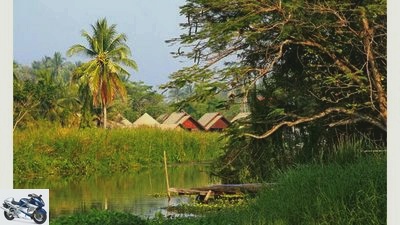
Iron ham
From small villages on the Granze to the national park, you go into the deep jungle.
In the evening in Kanchanaburi: frogs croak, disco boats boom across the Kwai. A train floats by and comes on the famous one “Bridge on the Kwai creaking to stand to the delight of the tourists standing around. During the Second World War, Australian, Dutch and British prisoners of war were forced here by the Japanese, the so-called “Build Death Railway. The route, which was built with great human losses, was intended to ensure the logistical connection between Bangkok and Rangoon in neighboring Burma. Connection between Thailand and Burma? My god, the pipeline! Come on, look for the traces of the Yadana pipeline, which was buried a good five meters deep from the Andaman Sea in Burma to Thailand – with Harry as interpreter and motorcycle scout to explore the route.
Passing orange-clad monks, rice fields and military cemeteries from the times of the death railway, we reach the Hellfire Pass: a memorial for around 400 prisoners of war who were here during the construction of the “Death Railway lost their lives. Then Sai Yok National Park emerges. Where the construction lane of the Yadana pipeline once ran, today rice, maize and undergrowth grow. Harry is looking for the ways of yore. Ask people about the access to the slope through the national park. “There is no way, say the villagers. “There is a way, Harry counters. And finally finds him too. A passage opens up next to a rotten wooden post that resembles a wild boar trail. “This is where you go in, Harry beams – and drives ahead with his Enduro. I’m chugging with that “Mountain goat after. The jungle path, which was initially barely a towel-wide, is no longer used by the villagers and has thus been forgotten. Huge ruts open up, which the rain has washed out of the ground. Often the trenches are so large that only a tire-wide track remains to drive around. We balance kilometer by kilometer, branches and bamboo canes hang so low over the slope that we have to duck our heads.
Out and about in Thailand part 2

Iron ham
Off through the bamboo jungle near Kanchana Buri. But there was not nearly as much space as here on many trails.
As soon as the motors go silent, the bushes creak and crackle. “Sai Yok National Park, which is around 1,000 square kilometers in size, I read in my travel guide, “is difficult to access, hardly populated and is inhabited by elephants and tigers. Harry, who stayed here in the tent when the pipeline was being built, can confirm that. At that time he had spotted tigers in a river bed, took out a forest elephant that had fallen into a shaft with a kind of ramp, and during the night he heard jungle noises that were louder than on any River Kwai disco boat. The proximity of a tiger, according to Harry, can be recognized by its extremely pungent, pungent smell. There is a strong smell everywhere here, so let’s get away.
At some point we pass a ranger station, which consists of a couple of corrugated iron-roofed huts, vegetable fields and roaming chickens. We signed the national park’s visitor book – and realized that we were the first European guests since the pipeline was built in 1998. Two corners further we come across a half-ingrown pipeline sign with kilometers. From here it is not far to Burma. A short time later we follow a fast dust track to the Khao Laem reservoir, which is fed by the Kwai River.
Back on asphalt, the enduros whiz around corners of all radii. Butterflies the size of a palm flutter through the air, birds of prey circle over us. Giant jungle stands on the way, bizarre cone karst can be seen in the distance. The small mountain road reveals grandiose panoramas, is framed by red and blue, almost soup-plate-sized flowers. Nearby is the pipeline that runs from Burma to Thailand right behind the border town under rolls of barbed wire and armed border guards. A soldier allows us to look over to the neighbors, where the Yadana-Pipe stretches as a color-recognizable lane through the forests to the Andaman Sea.
On the way back, a stop at a food stall. A murmur goes through the room as we enter in cross clothes. Harry, with his knowledge of Thai, has to provide information about where we come from and where we want to go. And tells that he was once involved in the construction of the gas pipeline. Even when the landlady brings us rice with meat and vegetables, Harry can’t stop spreading adventure stories.
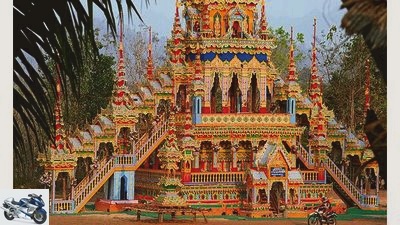
Iron ham
The Mon temple in Sankhla Buri looks like from another world.
We quickly refuel at the exit of the village, which runs from three Coca-Cola bottles into our tanks, then we speed over Thong Pha Phum and Sankhlaburi towards the Three Pagoda Pass. A dreamlike serpentine route opens up, with bizarre turns that the “Mountain goats demand increased maneuverability. Uphill: serpentine lines, downhill: serpentine lines. In between, brilliant views of the glittering Khao Laem reservoir.
Behind Sankhla Buri there are stilt houses and street stalls with handcrafted brooms. While I’m still pondering who should buy so many brooms here, the road ends at a roundabout with three small pagodas: the Three Pagoda Pass. Behind it is the terminus; because, we learn from the resident traders, the border to Burma is closed until further notice. Damn. We wanted to follow the course of the Yadana pipeline on the Burmese side for a while.
Does not matter. We park the enduro bikes between the stalls and look at what the dealers have to offer. There are fist-sized gemstones to buy, real and fake, sandalwood soap, medicinal herbs, “Myanmar Whiskey Extra Special and “Myanmar Lager Beer from a can. Burmese traders who venture a few steps into Thailand through small wooden gates sell orchids in pots. I discover goat heads in oil, which, according to the sellers, are not suitable for consumption. The oil is more suitable for tense muscles – especially in motorcyclists.
We’d rather not buy anything and turn the bikes around. We tumble back to Sai Yok National Park, then offroad via Erawan and Chaloem Rattanakosin National Park to the royal city of Ayutthaya. You should have seen it! It goes on, the enduros pull long plumes of dust behind them here, the rear wheel often breaks, we whiz through the smells of cookshops and jungle and are just happy. Because the reality is even better than the dream of enduro riding in Thailand.
Info about Thailand
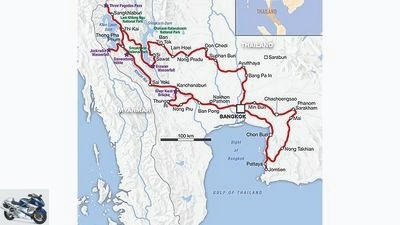
Drawing: archive
Capital: Bangkok – Area: 513115 km² – Founding: 1238 AD – Currency: Thai Baht – Population: 64 185 600 – Travel time: 10 days – Distance covered: 1700 kilometers.
Getting there:
Thai Airways flies several times a day from Frankfurt and Munich to Bangkok. Prices start at around 500 euros. Information under Tel .: 069/92874444, www.thaiair.com
Currency:
The unit of currency in Thailand is the Thai Baht (THB) with 100 Satang. For one euro you get around 46.50 Thai Baht. Current exchange rates at www.oanda.com.
Travel time:
Thailand enjoys a tropical climate due to its proximity to the equator and is easy to travel all year round. From November to February it is dry and between 23 and 26 degrees. From March to May it is hotter with 28 to 30 degrees. In the period from May to October there are short tropical downpours, the landscape is then lush green.
Worth seeing:
In addition to the obligatory temple visits, the Thai national parks beckon. The Chaolem Rattanakosin National Park is attractive. The access to the core zone leads through a 300 meter long stalactite cave. There are waterfalls and a 30 meter high natural bridge that has arisen from a huge stalactite cave. Overnight stay in pile-dwelling bungalows within the national park area is possible. Information can be found on the Internet at www.dnp.go.th. For history buffs: the World War II Museum in Kanchanaburi and the JEATH War Museum near Kanchanaburi (in Wat Chai Chumphon on the Mae Klong River). If you want to experience tigers up close, you can visit 40 kilometers northwest of Kanchanaburi den “Tiger Temple. In the forest monastery, which has developed into a tiger station over the years, twelve monks and 17 big cats live peacefully together. Information under phone 0066-34-531-557 or www.tigertempel.org.
Motorcycle tours:
The German-speaking operator Off-Road Tours offers guided tours on 200 to 250 cubic enduros. Telephone in D: 05254/7860, in Thailand (in German): 0066-53-482652 or www.off-roadtours.de. For a ten day tour “River Kwai Adventure costs 1450 euros per person without a flight. The price includes a rental motorcycle, fuel, accommodation, food and entrance fees.
Overnight stay:
With a great view over the city: Amari Atrium Hotel, 1880 New Petchburi Road, Bangkok, Telephone 0066-2718-20001, www.amari.com. Inexpensive, in the historical center: Royal Hotel, Rajdammern Avenue, Bangkok 10200, phone 0066-2-2229111, email: rervation@rattanakosin-hotel.com. Just two kilometers from the legendary River Kwai Bridge: Sugarcane Guesthouse, 22 Soi Pakistan, Maenam Kwae Road, Kanchanaburi, Phone 0066-34-624520, www.sugarcaneguesthouse.com. You spend the night in floating bungalows on the River Kwai.
Literature / addresses:
Recommended: Stefan Loose Travel Handbook “Thailand, 24.95 euros. The map is also useful “Thailand from Nelles Verlag, scale 1: 1,500,000, 7.90 euros. Further information: Thai Tourist Office, phone 069/1381390, www.thailandtourismus.de
Related articles
-
to travel Thailand Thailand Travels in 2543 No, this is not a vision of the future; 2543 is the year 2000 – according to the Buddhist calendar. But…
-
On the way: Adventure story Thailand
Henniges to travel On the way: Adventure story Thailand Traveling Adventure in Thailand: traveling with a tuk tuk It is 783 kilometers from Chiang Mai to…
-
Motorcycle tour in Northern Thailand
Jo Deleker 36 pictures Deleker 1/36 Traveling by motorcycle in Northern Thailand. Deleker 2/36 Traveling by motorcycle in Northern Thailand. Deleker 3/36…
-
Motorcycle production country Thailand: Ducatis now also from Thailand?
Ducati counselor traffic & business Motorcycle production country Thailand: Ducatis now also from Thailand? Thailand is the number 5 motorcycle…
-
Despite broken collarbone: Schrotter starts at the GP of Thailand
Ortema Sports & scene Motorsport Despite broken collarbone: Schrotter starts at the GP of Thailand Despite a broken collarbone Marcel Schrotter starts at…
-
Harley-Davidson bypasses penalty tax: European models come from Thailand
counselor traffic & business Harley-Davidson bypasses penalty tax: European models come from Thailand Harley-Davidson bypasses penalty tax Europe models…
-
Triumph relocates production: almost all models from Thailand
triumph counselor traffic & business Triumph relocates production: almost all models from Thailand Triumph relocates production Almost all models from…
-
2snap Sports & scene Motorsport MotoGP 2018 Buriram Thailand MotoGP 2018 in Buriram (Thailand) Marquez wins in Buriram After an exciting duel with Andrea…
-
to travel South Africa South Africa From the monkey valley to hell In the western and eastern Cape provinces of South Africa there are some almost…
-
Bavarian Forest, Bohemian Forest
Iron ham to travel Bavarian Forest, Bohemian Forest Bavarian Forest, Bohemian Forest Everything OK Real forest wilderness is emerging just around the…